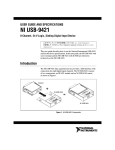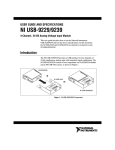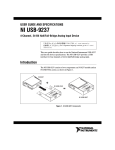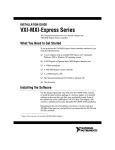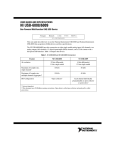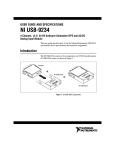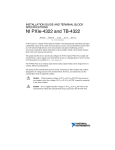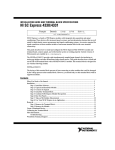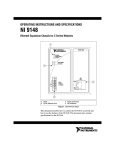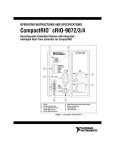Download National Instruments USB-9472 User's Manual
Transcript
USER GUIDE AND SPECIFICATIONS NI USB-9472 8-Channel, 24 V Logic, Sourcing Digital Output Device This user guide describes how to use the National Instruments NI USB-9472 and lists the device specifications. In this user guide, the NI USB-9472 with screw terminal and the NI USB-9472 with D-SUB are referred to inclusively as the NI USB-9472. Introduction The NI USB-9472 data acquisition device provides a USB interface for eight channels of digital outputs with integrated signal conditioning. The NI USB-9472 consists of two components: an NI 9472 module and an NI USB-9162 carrier, as shown in Figure 1. NI 9472 Hi- Sp N IU S B -9 16 2 eed US BC arr NI USB-9162 ier Hi- eed SP N IU S B -9 16 2 NI USB-9472 Figure 1. NI USB-9472 Components US BC arr ier Dimensions Figures 2 and 3 show the NI USB-9472 device dimensions. Hi-Speed USB Carrier NI USB-9162 140.23 mm (5.521 in.) 120.68 mm (4.751 in.) 137.82 mm (5.426 in.) 118.26 mm (4.656 in.) 88.12 mm (3.469 in.) 25.34 25.34 mm (0.998 in.) (0.998) Figure 2. NI USB-9472 (Screw Terminal) Device in Millimeters (Inches) Hi-Speed USB Carrier NI USB-9162 125.76 mm (4.951 in.) 120.68 mm (4.751 in.) 123.38 mm (4.857 in.) 118.26 mm (4.656 in.) 88.12 mm (3.469 in.) 25.34 mm (0.998 in.) Figure 3. NI USB-9472 (D-SUB) Device in Millimeters (Inches) NI USB-9472 User Guide and Specifications 2 ni.com Safety Guidelines Operate the NI USB-9472 only as described in these operating instructions. Although the NI 9472 module may have more stringent certification standards than the NI USB-9472, when used with the NI USB-9162 carrier, the combined system may be limited. Refer to the Specifications section for more details. Note Hot Surface This icon denotes that the component may be hot. Touching this component may result in bodily injury. Do not disconnect I/O-side wires or connectors unless power has been switched off or the area is known to be nonhazardous. Caution Caution Do not remove modules unless power has been switched off or the area is known to be nonhazardous. Caution The NI USB-9472 is not certified for use in hazardous locations. Safety Guidelines for Hazardous Voltages If hazardous voltages are connected to the module, take the following precautions. A hazardous voltage is a voltage greater than 42.4 Vpk or 60 VDC to earth ground. Ensure that hazardous voltage wiring is performed only by qualified personnel adhering to local electrical standards. Caution Caution Do not mix hazardous voltage circuits and human-accessible circuits on the same module. Make sure that devices and circuits connected to the module are properly insulated from human contact. Caution Caution When module terminals are live with hazardous voltages, make sure that the terminals are not accessible by using the high voltage screw terminal backshell. Refer to the Connecting Devices to the NI USB-9472 section for more information. © National Instruments Corporation 3 NI USB-9472 User Guide and Specifications Related Documentation Each application software package and driver includes information about writing applications for taking measurements and controlling measurement devices. The following references to documents assume you have NI-DAQmx 8.7 or later, and where applicable, version 7.1 or later of the NI application software. NI-DAQmx for Windows The DAQ Getting Started Guide describes how to install your NI-DAQmx for Windows software, your NI-DAQmx-supported DAQ device, and how to confirm that your device is operating properly. Select Start»All Programs»National Instruments»NI-DAQ»DAQ Getting Started Guide. The NI-DAQ Readme lists which devices are supported by this version of NI-DAQ. Select Start»All Programs»National Instruments»NI-DAQ» NI-DAQ Readme. The NI-DAQmx Help contains general information about measurement concepts, key NI-DAQmx concepts, and common applications that are applicable to all programming environments. Select Start»All Programs»National Instruments»NI-DAQ»NI-DAQmx Help. LabVIEW If you are a new user, use the Getting Started with LabVIEW manual to familiarize yourself with the LabVIEW graphical programming environment and the basic LabVIEW features you use to build data acquisition and instrument control applications. Open the Getting Started with LabVIEW manual by selecting Start»All Programs»National Instruments»LabVIEW»LabVIEW Manuals or by navigating to the labview\manuals directory and opening LV_Getting_Started.pdf. Use the LabVIEW Help, available by selecting Help»Search the LabVIEW Help in LabVIEW, to access information about LabVIEW programming concepts, step-by-step instructions for using LabVIEW, and reference information about LabVIEW VIs, functions, palettes, menus, and tools. Refer to the following locations on the Contents tab of the LabVIEW Help for information about NI-DAQmx: • Getting Started»Getting Started with DAQ—Includes overview information and a tutorial to learn how to take an NI-DAQmx measurement in LabVIEW using the DAQ Assistant. • VI and Function Reference»Measurement I/O VIs and Functions—Describes the LabVIEW NI-DAQmx VIs and properties. NI USB-9472 User Guide and Specifications 4 ni.com • Taking Measurements—Contains the conceptual and how-to information you need to acquire and analyze measurement data in LabVIEW, including common measurements, measurement fundamentals, NI-DAQmx key concepts, and device considerations. LabWindows/CVI The Data Acquisition book of the LabWindows/CVI Help contains measurement concepts for NI-DAQmx. This book also contains Taking an NI-DAQmx Measurement in LabWindows/CVI, which includes step-by-step instructions about creating a measurement task using the DAQ Assistant. In LabWindows™/CVI™, select Help»Contents, then select Using LabWindows/CVI»Data Acquisition. The NI-DAQmx Library book of the LabWindows/CVI Help contains API overviews and function reference for NI-DAQmx. Select Library Reference»NI-DAQmx Library in the LabWindows/CVI Help. Measurement Studio If you program your NI-DAQmx-supported device in Measurement Studio using Visual C++, Visual C#, or Visual Basic .NET, you can interactively create channels and tasks by launching the DAQ Assistant from MAX or from within Visual Studio .NET. You can generate the configuration code based on your task or channel in Measurement Studio. Refer to the DAQ Assistant Help for additional information about generating code. You also can create channels and tasks, and write your own applications in your ADE using the NI-DAQmx API. For help with NI-DAQmx methods and properties, refer to the NI-DAQmx .NET Class Library or the NI-DAQmx Visual C++ Class Library included in the NI Measurement Studio Help. For general help with programming in Measurement Studio, refer to the NI Measurement Studio Help, which is fully integrated with the Microsoft Visual Studio .NET help. To view this help file in Visual Studio. NET, select Measurement Studio» NI Measurement Studio Help. To create an application in Visual C++, Visual C#, or Visual Basic .NET, follow these general steps: 1. In Visual Studio .NET, select File»New»Project to launch the New Project dialog box. 2. Find the Measurement Studio folder for the language you want to create a program in. 3. Choose a project type. You add DAQ tasks as a part of this step. © National Instruments Corporation 5 NI USB-9472 User Guide and Specifications ANSI C without NI Application Software The NI-DAQmx Help contains API overviews and general information about measurement concepts. Select Start»All Programs»National Instruments»NI-DAQ»NI-DAQmx Help. The NI-DAQmx C Reference Help describes the NI-DAQmx Library functions, which you can use with National Instruments data acquisition devices to develop instrumentation, acquisition, and control applications. Select Start»All Programs»NationalInstruments»NI-DAQ» NI-DAQmx C Reference Help. .NET Languages without NI Application Software With the Microsoft .NET Framework version 1.1 or later, you can use NI-DAQmx to create applications using Visual C# and Visual Basic .NET without Measurement Studio. You need Microsoft Visual Studio .NET 2003 or Microsoft Visual Studio 2005 for the API documentation to be installed. The installed documentation contains the NI-DAQmx API overview, measurement tasks and concepts, and function reference. This help is fully integrated into the Visual Studio .NET documentation. To view the NI-DAQmx .NET documentation, go to Start»Programs»National Instruments»NI-DAQ»NI-DAQmx .NET Reference Help. Expand NI Measurement Studio Help»NI Measurement Studio .NET Class Library»Reference to view the function reference. Expand NI Measurement Studio Help»NI Measurement Studio .NET Class Library»Using the Measurement Studio .NET Class Libraries to view conceptual topics for using NI-DAQmx with Visual C# and Visual Basic .NET. To get to the same help topics from within Visual Studio, go to Help»Contents. Select Measurement Studio from the Filtered By drop-down list and follow the previous instructions. Device Documentation and Specifications NI-DAQmx includes the Device Document Browser, which contains online documentation for supported DAQ, SCXI, and switch devices, such as help files describing device pinouts, features, and operation, and PDF files of the printed device documents. You can find, view, and/or print the documents for each device using the Device Document Browser at any time by inserting the CD. After installing the Device Document Browser, device documents are accessible from Start»All Programs»National Instruments»NI-DAQ»Browse Device Documentation. Note You can download these documents at ni.com/manuals. NI USB-9472 User Guide and Specifications 6 ni.com Training Courses If you need more help getting started developing an application with NI products, NI offers training courses. To enroll in a course or obtain a detailed course outline, refer to ni.com/training. Technical Support on the Web For additional support, refer to ni.com/support or zone.ni.com. Installing the Software Software support for the NI USB-9472 for Windows Vista/XP/2000 is provided by NI-DAQmx. The DAQ Getting Started Guide, which you can download at ni.com/manuals, offers NI-DAQmx users step-by-step instructions for installing software and hardware, configuring channels and tasks, and getting started developing an application. Installing Other Software If you are using other software, refer to the installation instructions that accompany your software. Example Programs The NI-DAQmx CD contains example programs that you can use to get started programming with the NI USB-9472. Refer to the NI-DAQmx for USB Devices Getting Started Guide that shipped with your device, and is also accessible from Start»All Programs»National Instruments» NI-DAQ, for more information. Installing the NI USB-9472 Device Before installing the device, you must install the software you plan to use with the device. Refer to the Installing the Software section of this guide and the documentation included with the software for more information. Installing the NI 9472 Device into the NI USB-9162 Carrier The NI 9472 module and NI USB-9162 carrier are packaged separately. Refer to Figure 4, while completing the following assembly steps: 1. Make sure that no signals are connected to the NI 9472 module. 2. Remove the protective cover from the 15-pin D-SUB connector. © National Instruments Corporation 7 NI USB-9472 User Guide and Specifications 3. Align the I/O module with the carrier, as shown in Figure 4. 1 1 High Voltage Screw Terminal Backshell Figure 4. Module Installation 4. Squeeze the latches and insert the NI 9472 module into the NI USB-9162 carrier. 5. Press firmly on the connector side of the NI 9472 module until the latches lock the module into place, as shown in Figure 5. Figure 5. Locking Module into Place NI USB-9472 User Guide and Specifications 8 ni.com Mounting the NI USB-9472 to a Panel Threaded inserts are located in the NI USB-9472 for mounting it to a panel. Refer to Figure 6 for dimensions. 85.7 mm (3.37 in.) 72.2 mm (2.84 in.) Threaded Insert M3 x 0.5 8.5 mm (0.34 in.) Max Depth 76.1 mm (3.00 in.) Figure 6. Module Dimensions in Millimeters (Inches) Connecting the NI USB-9472 to a Computer Plug one end of the USB cable into the NI USB-9472 and the other end into an available USB port on the computer. Refer to the NI-DAQmx for USB Devices Getting Started Guide that shipped with your device, and is also accessible from Start»All Programs»National Instruments»NI-DAQ, for more information. LED Indicator The NI USB-9472 device has a green LED next to the USB connector. The LED indicator indicates device status, as listed in Table 1. When the device is connected to a USB port, the LED blinks steadily to indicate that the device is initialized and is receiving power from the connection. If the LED is not blinking, it may mean that the device is not initialized or the computer is in standby mode. In order for the device to be recognized, the device must be connected to a computer that has NI-DAQmx installed on it. If your device is not blinking, make sure your computer has the latest version of NI-DAQmx installed on it, and the computer is not in standby mode. © National Instruments Corporation 9 NI USB-9472 User Guide and Specifications Table 1. LED State/Device Status LED State Device Status Not lit Device not connected or in suspend. On, not blinking Device connected, but no module installed. Single-blink Operating normally. Double-blink Operating normally. Quadruple-blink Device error. Refer to ni.com/support. Wiring the NI USB-9472 Device The NI USB-9472 provides connections for eight digital output channels. A high voltage screw terminal backshell must be installed when using hazardous voltages (>42.4 Vpk, 60 VDC). Caution Note Table 2 illustrates the accessories available from ni.com for use with the NI USB-9472. Table 2. Accessories Device Accessory Accessory Description USB-9472 with Screw Terminal NI 9932 10-terminal, detachable, high voltage, screw terminal backshell1 USB-9472 with 25-pin D-SUB NI 9934 25-pin D-SUB connector 1 For more information about installing the backshell, refer to the Assembling the High Voltage Screw Terminal Backshell section. Each channel of the NI USB-9472 has a terminal or pin, DO, to which you can connect your device. Each channel has an LED that indicates the state of the channel. NI USB-9472 User Guide and Specifications 10 ni.com You must connect an external power supply to the NI USB-9472. This power supply provides the current for the devices you connect to the module. Connect the positive lead of the power supply to the supply terminal or pin, Vsup, and the negative lead of the power supply to the common terminal or pin, COM. The eight digital output channels are internally referenced to COM. Refer to Table 3 for the terminal assignments of the NI USB-9472 with screw terminal. Refer to Figure 7 for the pin assignments of the NI USB-9472 with D-SUB. Table 3. Terminal Assignments Module 0 3 4 7 0 1 2 3 4 5 6 7 8 9 © National Instruments Corporation 11 Terminal Signal 0 DO0 1 DO1 2 DO2 3 DO3 4 DO4 5 DO5 6 DO6 7 DO7 8 Supply (Vsup) 9 Common (COM) NI USB-9472 User Guide and Specifications DO0 Vsup DO1 DO2 Vsup DO3 DO4 Vsup DO5 DO6 Vsup DO7 0 3 4 7 14 15 16 17 18 19 20 21 22 23 24 25 1 2 3 4 5 6 7 8 9 10 11 12 13 COM Vsup COM COM Vsup COM COM Vsup COM COM Vsup COM COM Figure 7. Pin Assignments Connecting Devices to the NI USB-9472 The NI USB-9472 has current sourcing outputs, meaning the DO terminal or pin drives current or applies voltage to the device to which it is connected. You can connect sinking-input devices, such as NPN, open collectors, normally high, IEC negative logic, or other DC devices to the NI USB-9472. A sinking-input device provides a path to ground for current or voltage. Make sure the device you connect to the NI USB-9472 meets the module specifications. Refer to the Specifications section for more information about the output specifications of the module. Connect the device to DO on the NI USB-9472. Connect the common of the device to COM. Figure 8 shows a possible configuration. NI USB-9472 User Guide and Specifications 12 ni.com Vsup + External Power _ Supply DO Device COM NI USB-9472 Figure 8. Connecting a Device to the NI USB-9472 When the channel is on, the channel LED is on and the terminal or pin associated with the channel drives a current or applies a voltage to the device. When the channel is off, the channel LED is off and the terminal or pin does not drive current or apply voltage to the device. Assembling the High Voltage Screw Terminal Backshell The NI 9932 high voltage screw terminal backshell must be installed when using hazardous voltages (>42.4 Vpk, 60 VDC). Refer to Figure 9 while completing the following steps to assemble the backshell: 1. Connect the leads to the screw terminal and secure with the strain relief. 2. Finish by snapping the backshell around the connector. 1 1 Strain Relief Figure 9. High Voltage Screw Terminal Backshell © National Instruments Corporation 13 NI USB-9472 User Guide and Specifications Figure 10. Assembled High Voltage Screw Terminal Backshell I/O Protection The NI USB-9472 is short-circuit-proof in accordance with IEC 1131-2 and provides overcurrent protection. Understanding Short-Circuit-Proof Devices Each channel on the NI USB-9472 has circuitry that protects it from current surges resulting from short circuits. Whether the module suffers damage from these overcurrent conditions depends on the following factors: • The amount of current through the channel • The amount of time the current is above the current limit • The frequency of the current surges When the amount of current through the DO terminal or pin is greater than the guaranteed trip current for the module, the channel trips and goes into an overcurrent state. In an overcurrent state, the channel turns off and the module is not damaged. If the current through DO is higher than the minimum possible trip current and lower than the guaranteed trip current, the state of the channel is indeterminate and depends on factors such as the current level, the temperature, and the power supply. To prevent false tripping, higher inrush currents that exist for less than the trip time do not trip the protection circuitry. Refer to the Specifications section for more information about the maximum continuous output current, trip current, and trip time. You also can refer to the IEC 1131-2 standard for more information about short-circuit-proof devices. Because the NI USB-9472 includes internal flyback diodes, you do not need to add external diodes when connecting to switching energy storing devices. Tip NI USB-9472 User Guide and Specifications 14 ni.com Power Supplies and Overcurrent Conditions If a short-circuit occurs, the current through DO can exceed the current rating for the power supply and the maximum continuous output current for the NI USB-9472. If the power supply you are using with the NI USB-9472 cannot supply more than the guaranteed trip current, the module may be damaged if a short-circuit condition occurs. Detecting an Overcurrent Condition If a device connected to the module is not working while the channel is on, the module channel may be in an overcurrent state. Neither the software nor the module LEDs indicate if an overcurrent condition occurs. A channel LED may be on even though the channel is off because of an overcurrent condition. To determine if the channel is in an overcurrent state, measure the voltage between DO and Vsup . If the voltage is equal to the voltage of the external power supply connected to the module, the channel is in an overcurrent state. Resetting Channels After an Overcurrent Condition After you have determined and fixed the cause of the overcurrent condition, reset the channel by turning it off. You can disconnect the external power supply from the module, however, doing so disconnects power from all of the module channels. Normal operation can resume after you correct the overcurrent condition and reset the channel. Specifications The following specifications are typical for the range 0 to 60 °C unless otherwise noted. All voltages are relative to COM unless otherwise noted. Output Characteristics Number of channels ............................... 8 digital output channels Output type............................................. Sourcing Supply voltage range (Vsup).................... 6 to 30 V Output voltage........................................ Vsup – (I0 · R0) Output impedance (R0)........................... 0.13 Ω max; 0.07 Ω typ Continuous output current (I0) ............... 0.75 A max per channel © National Instruments Corporation 15 NI USB-9472 User Guide and Specifications I/O protection Voltage ............................................30 V max Reversed voltage .............................None Trip currents Minimum possible trip current ................................6 A Minimum guaranteed trip current ................................13 A Current Channel State Module State 0 to 1 A Channel does not trip Module is not damaged 1 to 6 A Channel does not trip Module may be damaged 6 to 13 A Channel may trip Module may be damaged >13 A Channel trips Module is not damaged Trip time ..........................................10 μs at 13 A Output delay time (full load) ..................100 μs max Power Requirements Current consumption from USB.............500 mA, max Suspend mode..................................2.5 mA, max Bus Interface USB specification ...................................USB 2.0 Hi-Speed Physical Characteristics Dimensions With combicon ................................14.0 cm × 8.8 cm × 2.5 cm (5.52 in. × 3.47 in. × 1.00 in.) With D-SUB ....................................12.6 cm × 8.8 cm × 2.5 cm (4.95 in. × 3.47 in. × 1.00 in.) Screw terminal wiring ............................12 to 24 AWG copper conductor wire with 10 mm (0.39 in.) of insulation stripped from the end Torque for screw terminals.....................0.5–0.6 N · m (4.4–5.3 lb · in.) NI USB-9472 User Guide and Specifications 16 ni.com Weight With screw terminal........................ Approx. 250 g (8.8 oz) With D-SUB ................................... Approx. 245 g (8.6 oz) Safety If you need to clean the module, wipe it with a dry towel. Safety Voltages NI USB-9472 with Screw Terminal Channel-to-COM ................................... 30 V max Isolation Channel-to-channel ......................... No isolation between channels Channel-to-earth ground Withstand................................. 2,300 Vrms, 5 seconds max Continuous............................... 250 Vrms, Measurement Category II Measurement Category II is for measurements performed on circuits directly connected to the electrical distribution system. This category refers to local-level electrical distribution, such as that provided by a standard wall outlet (for example, 115 V for U.S. or 230 V for Europe). NI USB-9472 with D-SUB Channel-to-COM ................................... 30 V max Isolation Channel-to-channel ......................... No isolation between channels Channel-to-earth ground Withstand................................. 1,000 Vrms, 5 seconds max Continuous............................... 60 VDC, Measurement Category I Measurement Category I is for measurements performed on circuits not directly connected to the electrical distribution system referred to as MAINS voltage. MAINS is a hazardous live electrical supply system that powers equipment. This category is for measurements of voltages from specially protected secondary circuits. Such voltage measurements include signal levels, special equipment, limited-energy parts of equipment, circuits powered by regulated low-voltage sources, and electronics. © National Instruments Corporation 17 NI USB-9472 User Guide and Specifications Safety Standards The NI USB-9472 product is designed to meet the requirements of the following standards of safety for electrical equipment for measurement, control, and laboratory use: Note • IEC 61010-1, EN-61010-1 • UL 61010-1, CSA 61010-1 For UL and other safety certifications, refer to the product label or visit ni.com/certification, search by model number or product line, and click the appropriate link in the Certification column. Hazardous Locations The NI USB-9472 is not certified for use in hazardous locations. Environmental The NI USB-9472 is intended for indoor use only. Operating temperature (IEC 60068-2-1, IEC 60068-2-2) ...........0 to 60 °C Storage temperature (IEC 60068-2-1, IEC 60068-2-2) ...........–40 to 85 °C Operating humidity (IEC 60068-2-56) ...................................10 to 90% RH, noncondensing Storage humidity (IEC 60068-2-56) ...................................5 to 95% RH, noncondensing Maximum altitude...................................2,000 m Pollution Degree (IEC 60664) ................2 Electromagnetic Compatibility This product is designed to meet the requirements of the following standards of EMC for electrical equipment for measurement, control, and laboratory use: Note • EN 61326 EMC requirements; Minimum Immunity • EN 55011 Emissions; Group 1, Class A • CE, C-Tick, ICES, and FCC Part 15 Emissions; Class A For EMC compliance, operate this device with double-shielded cables. NI USB-9472 User Guide and Specifications 18 ni.com CE Compliance This product meets the essential requirements of applicable European Directives, as amended for CE marking, as follows: • 2006/95/EC; Low-Voltage Directive (safety) • 2004/108/EC; Electromagnetic Compatibility Directive (EMC) Refer to the Declaration of Conformity (DoC) for this product for any additional regulatory compliance information. To obtain the DoC for this product, visit ni.com/certification, search by model number or product line, and click the appropriate link in the Certification column. Note Environmental Management National Instruments is committed to designing and manufacturing products in an environmentally responsible manner. NI recognizes that eliminating certain hazardous substances from our products is beneficial not only to the environment but also to NI customers. For additional environmental information, refer to the NI and the Environment Web page at ni.com/environment. This page contains the environmental regulations and directives with which NI complies, as well as other environmental information not included in this document. Waste Electrical and Electronic Equipment (WEEE) EU Customers At the end of their life cycle, all products must be sent to a WEEE recycling center. For more information about WEEE recycling centers and National Instruments WEEE initiatives, visit ni.com/environment/weee.htm. ⬉ᄤֵᙃѻક∵ᶧࠊㅵ⧚ࡲ⊩ ˄Ё RoHS˅ Ёᅶ᠋ National Instruments ヺড়Ё⬉ᄤֵᙃѻકЁ䰤ࠊՓ⫼ᶤѯ᳝ᆇ⠽䋼ᣛҸ (RoHS)DŽ ݇Ѣ National Instruments Ё RoHS ড়㾘ᗻֵᙃˈ䇋ⱏᔩ ni.com/environment/rohs_chinaDŽ (For information about China RoHS compliance, go to ni.com/environment/rohs_china.) © National Instruments Corporation 19 NI USB-9472 User Guide and Specifications Where to Go for Support The National Instruments Web site is your complete resource for technical support. At ni.com/support you have access to everything from troubleshooting and application development self-help resources to email and phone assistance from NI Application Engineers. National Instruments corporate headquarters is located at 11500 North Mopac Expressway, Austin, Texas, 78759-3504. National Instruments also has offices located around the world to help address your support needs. For telephone support in the United States, create your service request at ni.com/support and follow the calling instructions or dial 512 795 8248. For telephone support outside the United States, contact your local branch office: Australia 1800 300 800, Austria 43 662 457990-0, Belgium 32 (0) 2 757 0020, Brazil 55 11 3262 3599, Canada 800 433 3488, China 86 21 5050 9800, Czech Republic 420 224 235 774, Denmark 45 45 76 26 00, Finland 358 (0) 9 725 72511, France 01 57 66 24 24, Germany 49 89 7413130, India 91 80 41190000, Israel 972 3 6393737, Italy 39 02 41309277, Japan 0120-527196, Korea 82 02 3451 3400, Lebanon 961 (0) 1 33 28 28, Malaysia 1800 887710, Mexico 01 800 010 0793, Netherlands 31 (0) 348 433 466, New Zealand 0800 553 322, Norway 47 (0) 66 90 76 60, Poland 48 22 3390150, Portugal 351 210 311 210, Russia 7 495 783 6851, Singapore 1800 226 5886, Slovenia 386 3 425 42 00, South Africa 27 0 11 805 8197, Spain 34 91 640 0085, Sweden 46 (0) 8 587 895 00, Switzerland 41 56 2005151, Taiwan 886 02 2377 2222, Thailand 662 278 6777, Turkey 90 212 279 3031, United Kingdom 44 (0) 1635 52354 National Instruments, NI, ni.com, and LabVIEW are trademarks of National Instruments Corporation. Refer to the Terms of Use section on ni.com/legal for more information about National Instruments trademarks. Other product and company names mentioned herein are trademarks or trade names of their respective companies. For patents covering National Instruments products, refer to the appropriate location: Help»Patents in your software, the patents.txt file on your CD, or ni.com/patents. © 2005–2007 National Instruments Corporation. All rights reserved. 371570D-01 Dec07




















